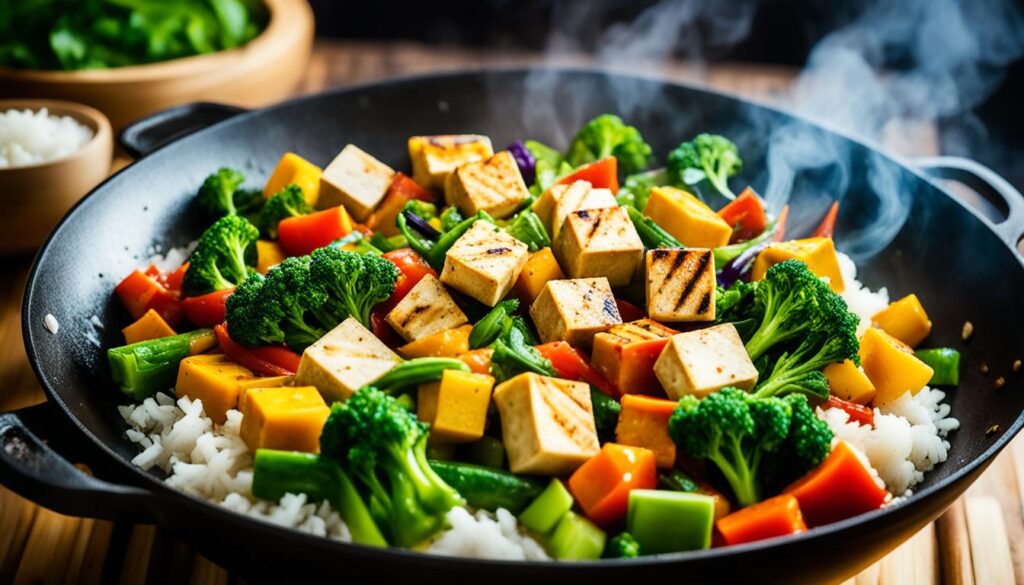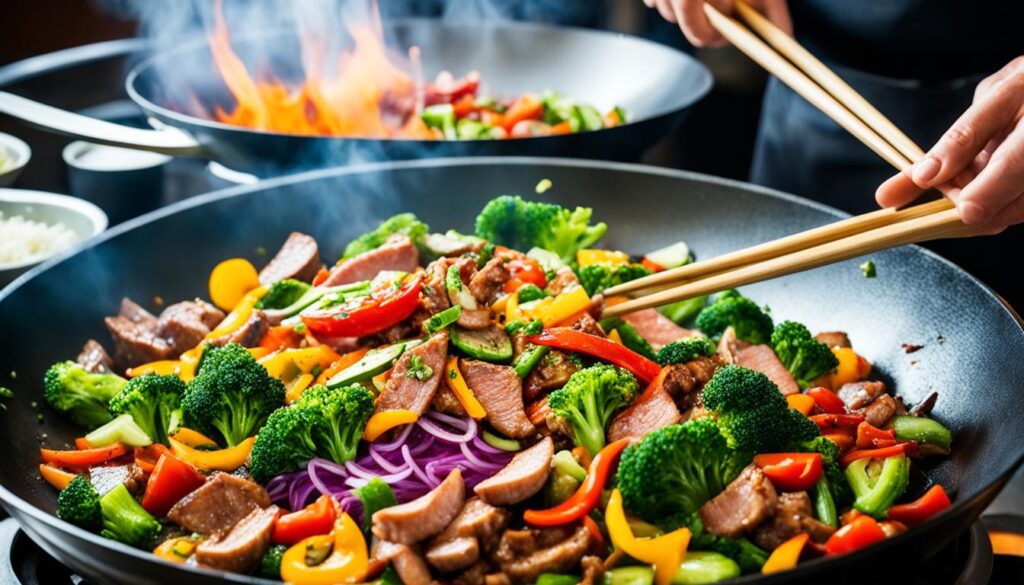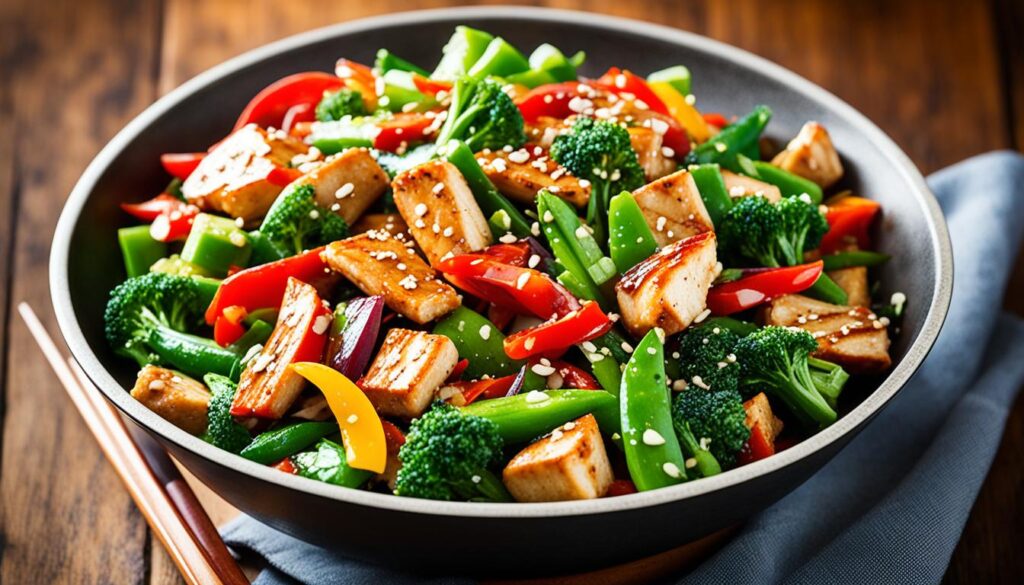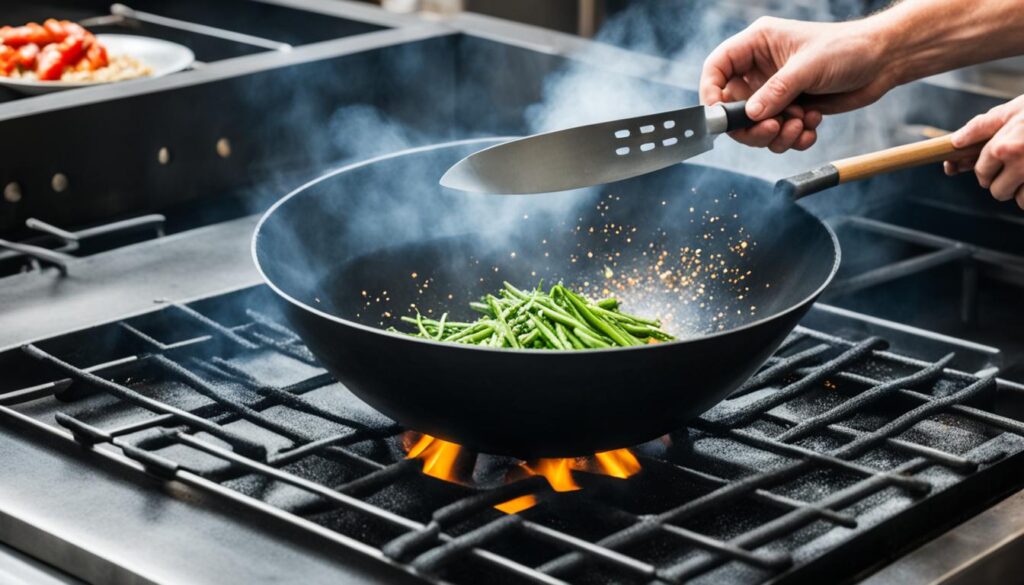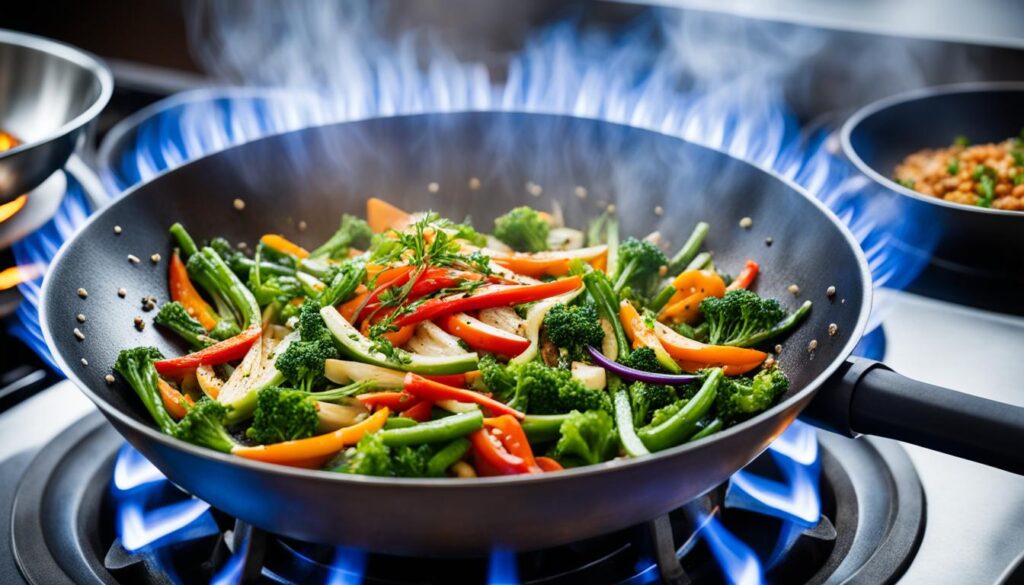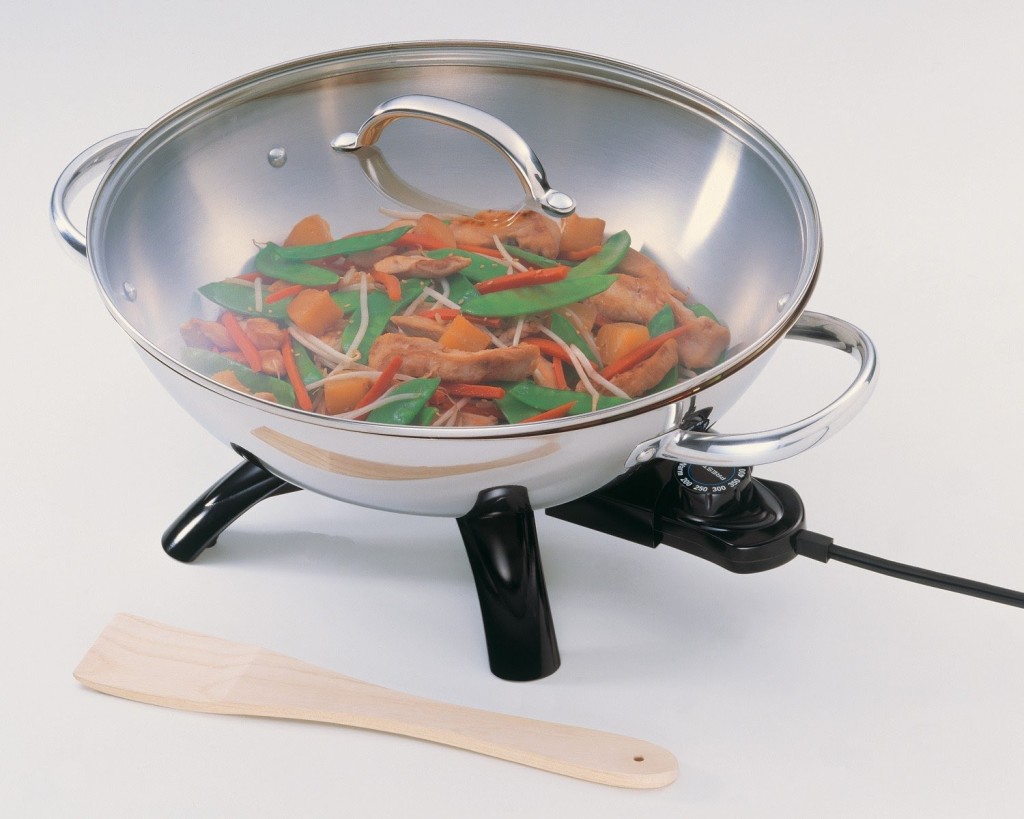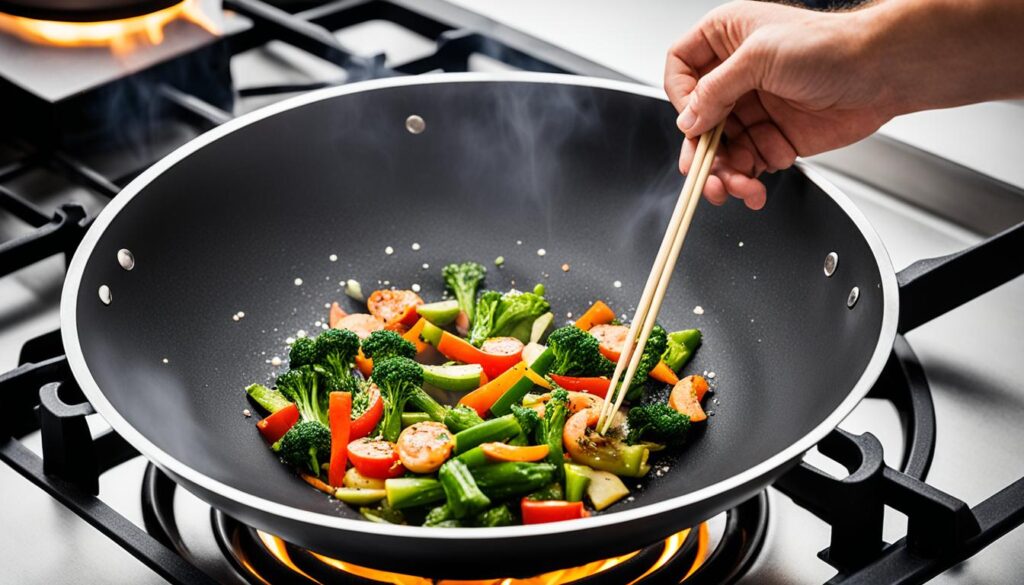Are you bored of the same old veggie stir-fries? Looking for new, vegan wok recipes to jazz up your meals? You’re in the right place! This collection has easy, tasty vegan wok meals. They’ll excite your taste buds and keep you eating healthy.
Imagine classic stir-fries and noodle dishes filled with colorful vegetables. These dishes are perfect for anyone wanting simple vegan cooking that tastes great. You’ll be surprised at how cooking veggies in stages and adding homemade sauces can improve your meals. Your food will reach new levels of deliciousness.
Key Takeaways
- Discover a variety of flavorful vegan wok recipes perfect for easy plant-based meals.
- Learn the art of cooking veggies in stages for optimal texture and flavor.
- Explore homemade sauces that enhance the taste of vegetable stir-fries.
- Find inspiration for incorporating more colorful and nutritious veggie combinations.
- Elevate your vegan cooking skills with recipes for classic dishes like Pad Thai and Chow Mein.
Contents
- 1 Mastering the Art of Vegan Stir-Fry
- 2 Colorful and Nutritious Veggie Combos
- 3 Classic Vegetable Stir-Fry
- 4 Crispy Tofu and Broccoli in Garlic Sauce
- 5 Vegan Pad Thai
- 6 Mushroom and Bok Choy Stir-Fry
- 7 Spicy Sichuan-Style Eggplant
- 8 Vegan “Beef” and Black Bean Sauce
- 9 Thai Basil Stir-Fry with Plant-Based Chicken
- 10 Vegan Singapore Noodles
- 11 Stir-Fried Tempeh with Peanut Sauce
- 12 Vegan Chow Mein
- 13 Tips for Perfect Vegan Wok Cooking
Mastering the Art of Vegan Stir-Fry
Stir-frying comes from Eastern Asia and has a long history. It combines skill, timing, and the best ingredients for great meals. For vegans, it’s key to create tasty, healthy dishes through stir-frying.
Cooking Vegetables in Stages
A top vegan stir-fry tip is to cook veggies in the right order. First, cook harder veggies like carrots and broccoli. Then, add softer greens like bok choy. This method keeps all veggies looking and tasting just right.
The Importance of Fresh Ingredients
The quality of veggies is crucial for a great stir-fry. Pick fresh, crisp ones for the best taste and nutrition. Garlic, ginger, and onions bring flavor depth, while mushrooms add a rich umami taste.
Creating a Flavorful Stir-Fry Sauce
A homemade stir-fry sauce can turn your dish into a star. Start with soy sauce, rice vinegar, and a sweet touch. Then, add your favorite spices and herbs. Ginger, garlic, chili paste, and sesame oil work wonders.
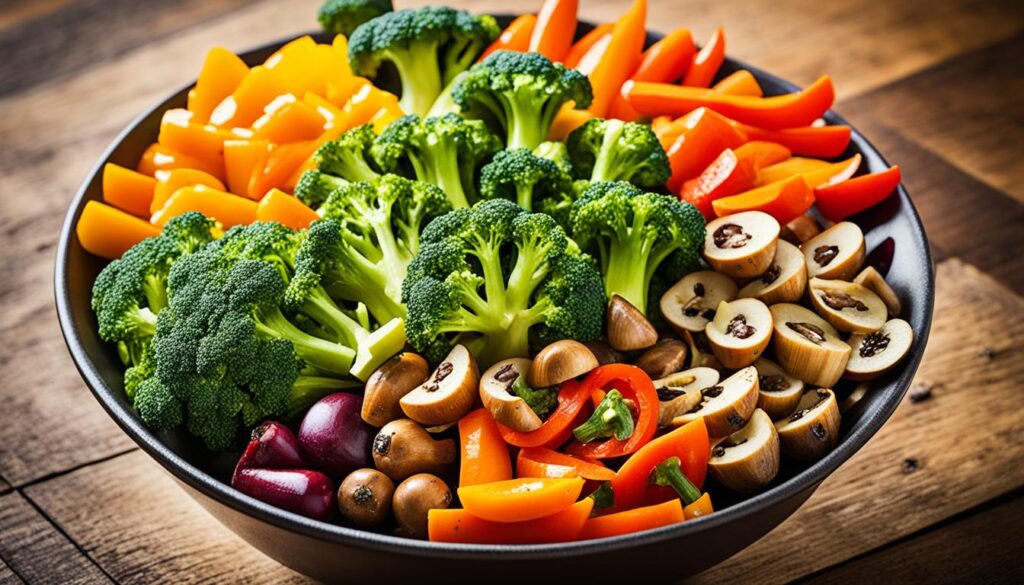
- Prep all ingredients in advance to ensure efficient cooking.
- Use a wok or large skillet heated to high heat for optimal searing.
- Add ingredients in the right order, starting with aromatics and hard veggies.
- Keep the ingredients moving constantly to prevent overcooking.
- Finish with a flavorful stir-fry sauce and serve immediately.
By learning and enjoying vegan stir-fry art, you’ll find joy in cooking. You can make mouth-watering, healthy meals that delight everyone.
Learn how to season a wok for the first
Colorful and Nutritious Veggie Combos
Creating tasty and healthy veggie stir-fries is easy and fun. You can mix colorful vegetables to make a dish that’s good for your eyes and body. Let’s look at some great veggie combinations for your next stir-fry.
Crunchy Cruciferous Stars: Broccoli and Cauliflower
Broccoli and cauliflower are stand-out ingredients in stir-fries. They give your meal a nice crunch and are packed with nutrients. Broccoli brings vitamin C, fiber, and antioxidants, and cauliflower adds folate and vitamin K.
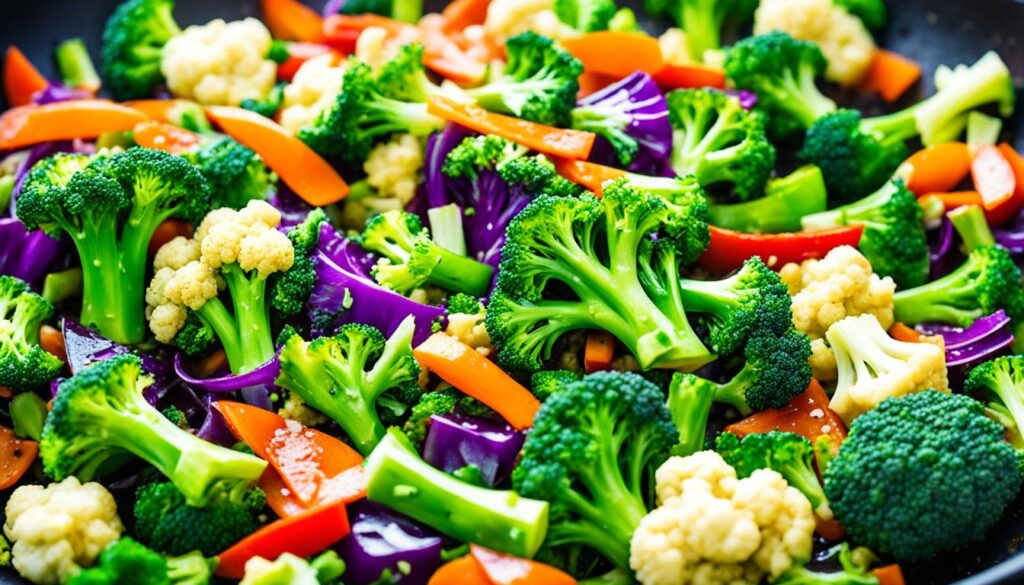
Sweet and Savory Root Veggies: Carrots and Onions
Adding carrots and onions gives your stir-fry a mix of sweet and savory tastes. Carrots brighten up the dish and bring their own natural sweetness. This flavor combo makes your meal more exciting.
- Carrots: Rich in beta-carotene and fiber
- Onions: Packed with antioxidants and beneficial compounds
Quick-Cooking Greens: Bok Choy and Bell Peppers
Bok choy and bell peppers are perfect for quick, crunchy stir-fries. Bok choy has a mild taste and keeps its crunch when cooked at high heat. Bell peppers add color and a mild sweetness that goes well with the other veggies.
| Vegetable | Nutrient Highlights |
|---|---|
| Bok Choy | Vitamin C, Vitamin K, Folate |
| Bell Peppers | Vitamin C, Vitamin A, Antioxidants |
With these veggies, you’ll make a dish that looks great and is full of important nutrients. So, grab your wok and start making veggie stir fry combinations that are both tasty and healthy!
Classic Vegetable Stir-Fry
I love making vegan stir fry and want to share my favorite vegetable medley stir fry recipe. This recipe celebrates fresh vegetables cooked perfectly in a wok. You can make this classic veggie stir fry your own by adding your preferred vegetables. This dish is perfect over rice or noodles.
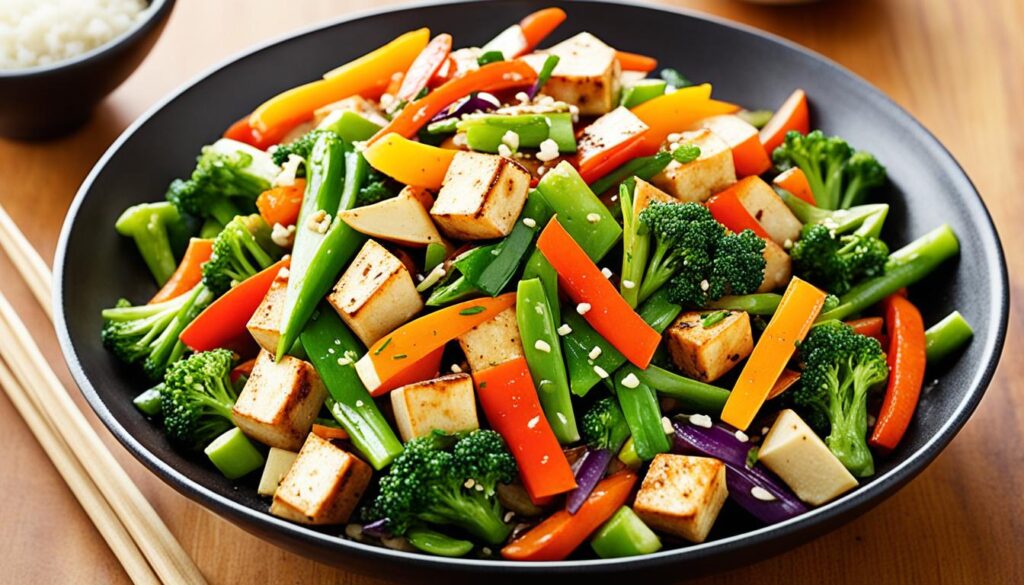
For an authentic wok taste, I use a powerful wok burner. It can reach up to 65,000 BTUs for quick stir-frying. For normal home cooking, a wok burner between 25,000 to 35,000 BTUs is great. Make sure your wok is between 12 to 16 inches for the best results at home.
Here’s what you’ll need for a delicious vegetable medley stir fry:
- A large wok or skillet
- Assorted fresh veggies (broccoli, carrots, bell peppers, snap peas, etc.)
- Vegetable oil or stir-fry oil
- Garlic and ginger (minced)
- Soy sauce or tamari
- Rice vinegar or apple cider vinegar
- Sesame oil
- Red pepper flakes (optional, for heat)
- Cooked rice or noodles (for serving)
| Ingredient | Quantity |
|---|---|
| Broccoli florets | 2 cups |
| Carrots, sliced | 1 cup |
| Bell peppers, sliced | 1 cup |
| Snap peas | 1 cup |
| Vegetable oil | 2 tablespoons |
| Garlic, minced | 2 cloves |
| Ginger, minced | 1 tablespoon |
| Soy sauce or tamari | 3 tablespoons |
| Rice vinegar | 2 tablespoons |
| Sesame oil | 1 teaspoon |
| Red pepper flakes (optional) | 1/4 teaspoon |
In making a veggie stir fry, it’s essential to cook the veggies separately. Start with the harder vegetables like broccoli and carrots. Keep the heat high and continuously move the wok or pan. This ensures the veggies cook evenly. Once done, add the sauce and mix thoroughly. Enjoy your classic veggie stir fry recipe with rice or noodles for a great meal.
Crispy Tofu and Broccoli in Garlic Sauce
Looking for a tasty, plant-based dish? Try this crispy tofu and broccoli in garlic soy sauce. It’s rich in protein and nutrients. This dish is quick to make and will quickly become your favorite.
Preparing the Perfect Tofu
Getting the right tofu texture is all about how you prepare it. First, press the extra-firm tofu to remove water. Then, cut it into pieces. Next, mix the tofu with cornstarch, garlic powder, thyme, salt, and pepper. This makes the tofu tasty and helps it get crispy when fried.
- Prep Time: 10 minutes
- Cook Time: 20 minutes
- Total Time: 30 minutes
- Yield: 3–4 servings
Balancing Flavors with Garlic and Soy
The garlic tofu sauce is what makes this meal special. Mix hoisin sauce, soy sauce, sesame oil, maple syrup, vinegar or lime juice, garlic, and ginger. This sauce gives the dish a tasty umami flavor.
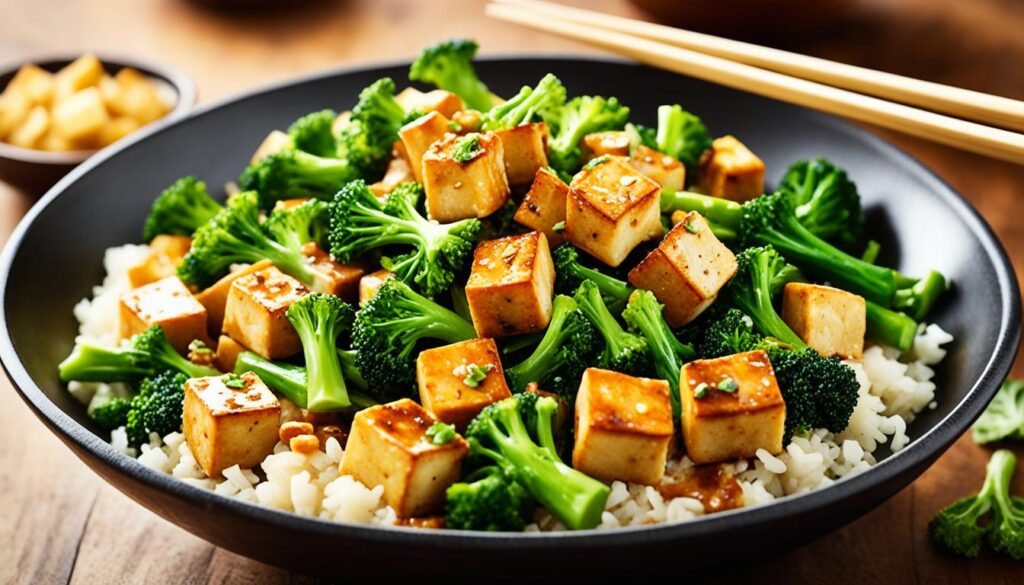
After frying the tofu, mix it with the broccoli and sauce. This creates a flavorful meal with a great mix of a garlic soy sauce. It also gives the veggies a nice crunch.
This dish is great for both experienced vegans and those new to plant-based food. Enjoy it over rice or noodles for a full meal. This dish is sure to win over anyone who tries it.
Vegan Pad Thai
Pad Thai is a classic Thai dish loved for its bold flavors and varying textures. This vegan version keeps all those authentic Thai flavors while skipping the animal products. Enjoy plant-based Thai noodles mixed with a tangy tamarind sauce, crispy tofu or tempeh, and fresh veggies. It’s a vegan pad thai that will take you to Bangkok’s bustling streets.
Recreating the Classic Thai Flavor
The secret to an outstanding vegan pad Thai is the sauce. It blends tamarind puree, coconut sugar, vegan fish sauce, soy sauce, and fresh lime juice. This mix creates a sweet, sour, salty balance that’s irresistible. For an egg-like taste without eggs, add a bit of black salt (kala namak).
Protein-Packed Plant-Based Pad Thai
While traditional pad Thai includes shrimp, this vegan version shines with tofu or tempeh. Pressed extra-firm tofu is fried to a crisp, offering a pleasing contrast to the noodles. Tempeh, a soybean cake, gives a nutty taste and earthy feel to the dish.
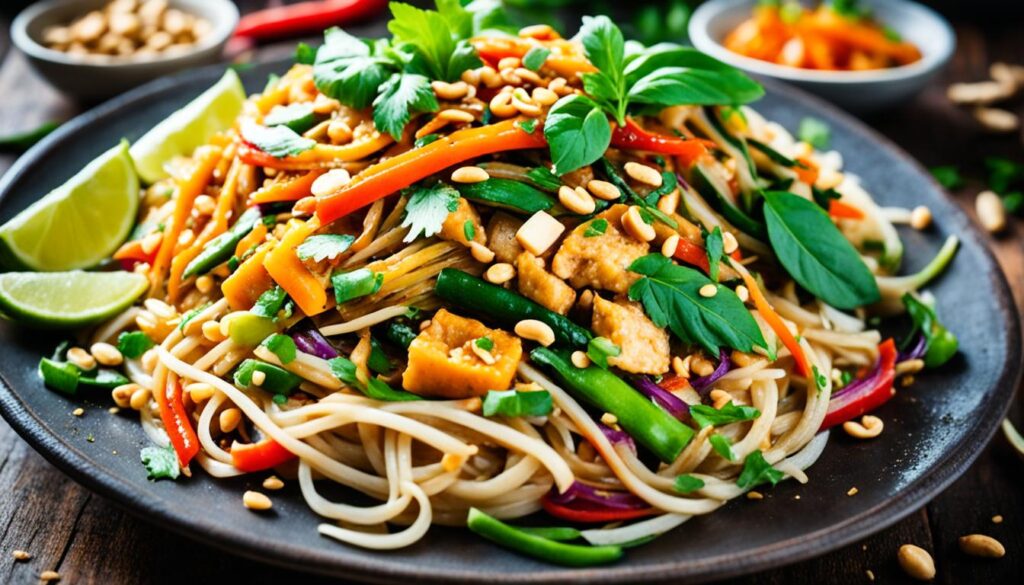
To enrich this vegan pad thai recipe, throw in your favorite veggies like carrots, bean sprouts, and bell peppers. Feel free to add your favorite plant-based options to make it your own.
- Recipe preparation time: 30 minutes
- Recommended serving size: 1 serving
- Nutritional information per serving:
- Calories: 500 kcal
- Carbohydrates: 68g
- Protein: 17g
- Fat: 19g
- Saturated Fat: 8g
- Sodium: 754mg
- Potassium: 585mg
- Fiber: 5g
- Sugar: 16g
- Vitamin A: 5571IU
- Vitamin C: 13mg
- Calcium: 111mg
- Iron: 3mg
To enhance flavor and save time, prep some ingredients in advance. You can store cooked rice noodles for 3 to 4 days. The sauce lasts up to a week. Prepare veggies and toppings ahead for 1 to 2 days. Tofu will keep fresh for up to a week when pressed and refrigerated.
Mushroom and Bok Choy Stir-Fry
Enjoy the mushroom bok choy stir fry with its rich flavors. It highlights the deep taste of mushrooms and the flexible bok choy. This dish is a delight for all your senses.
Celebrating the Umami Mushroom
Mushrooms are packed with umami goodness. They bring a rich flavor everyone loves. Umami mushroom dishes hit the spot with their satisfying, meat-like texture.
Choose from classic button, shiitake, or oyster mushrooms. They all have this earthy taste that’s sure to please.
- Shiitake mushrooms are a popular choice, boasting an intense umami flavor and firm texture.
- Oyster mushrooms offer a delicate, velvety texture and a mild, nutty taste.
- Cremini or baby bella mushrooms provide a robust, meaty flavor and a versatile canvas for other ingredients.
Bok Choy: The Versatile Asian Green
Bok choy, or Chinese cabbage, is full of nutrients. It brings a nice crunch and freshness to meals. Thanks to its tender stems and soft leaves, bok choy works well in various dishes.
To start the mushroom bok choy stir fry, chop the mushrooms and bok choy. Then, cook garlic and ginger in a wok. Add the mushrooms and bok choy stems, letting them get flavorful.
Toss in bok choy leaves and season with sauces like soy sauce or oyster sauce. A bit of rice vinegar can add a refreshing twist.
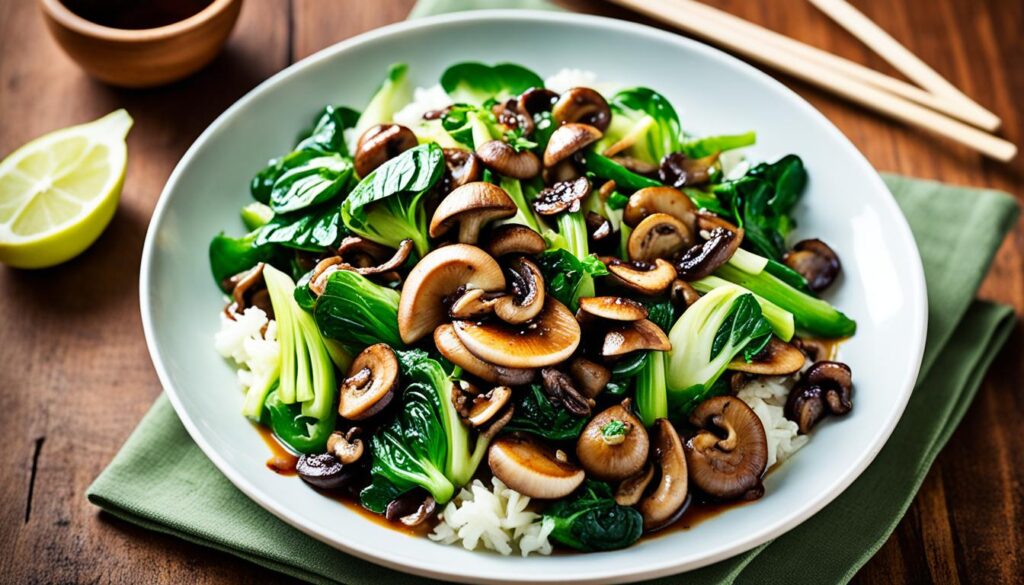
This dish is perfect as a main meal or a side. Serve it with rice or noodles for a fully satisfying dinner. It truly showcases the best of plant-based cooking.
Spicy Sichuan-Style Eggplant
Get ready to spice things up with Sichuan cuisine! This sichuan eggplant stir fry will awaken your taste buds. The key ingredient is eggplant, which easily soaks up flavors. It’s perfect for showcasing the bold taste of sichuan peppercorns.
The Wonders of Sichuan Peppercorns
The sichuan peppercorn is the secret behind this dish. It’s a small but mighty spice that makes Sichuan food stand out. When you eat it, a tingling, citrusy sensation takes over. This unique flavor combined with a slight numbing effect is truly memorable.
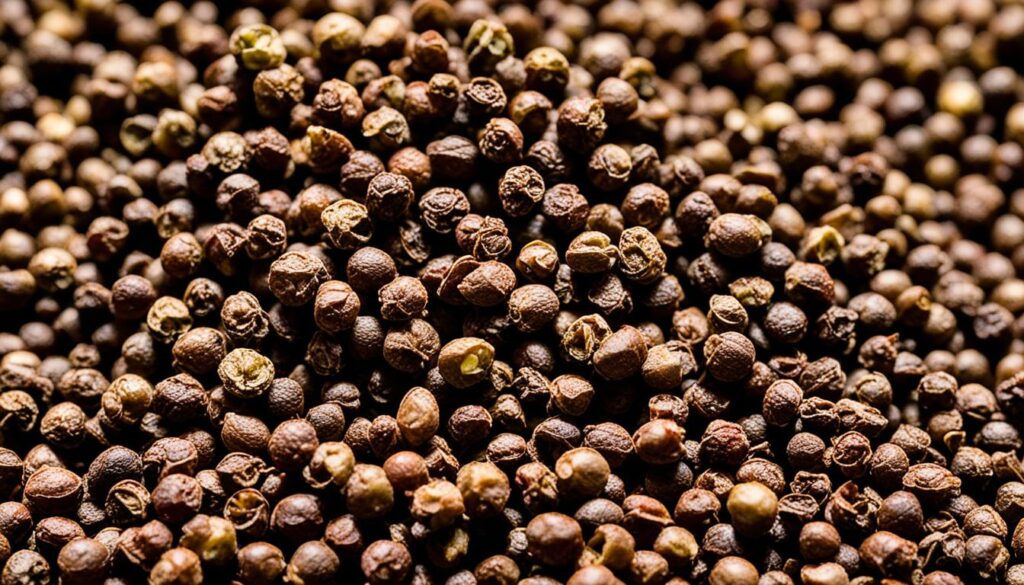
Eggplant: A Sponge for Flavors
Eggplant’s ability to soak up flavors makes it a star here. We pick long Chinese eggplants for their great texture and taste. Here’s how to prep your eggplant just right:
- Brine the eggplant before cooking to achieve a firmer bite and prevent sogginess.
- Cook the eggplant in batches to ensure even browning and caramelization.
- Opt for smaller, thinner eggplants, as larger varieties can become watery when cooked.
By following these steps, the eggplant turns into a flavor sponge. It’s ready to absorb the exciting taste of the sichuan eggplant stir fry sauce.
| Rating | Prep Time | Cook Time | Servings |
|---|---|---|---|
| 4.96/5 | 5 mins | 15 mins | 2 |
Try out this flavorful sichuan eggplant stir fry for a taste of Sichuan. Feel the unique tingle of sichuan peppercorns on your taste buds. Meanwhile, the eggplant does its job, soaking up all the fiery goodness.
Vegan “Beef” and Black Bean Sauce
Craving a savory stir-fry but staying plant-based? Try this vegan “beef” and black bean sauce dish. It uses meat alternatives and rich sauces to mimic beef stir-fry flavors, totally without animal products.
Plant-Based Meat Alternatives
The main star here is the plant-based meat substitute. You’ll find many options that taste and feel like beef, such as those from soy, wheat, or pea protein. A few top picks are:
- Seitan (wheat gluten)
- Soy-based “beef” crumbles or strips
- Pea protein-based “beef” chunks
These meat alternatives are widely available in grocery stores or health food markets. Choose one with a chewy texture and great umami flavor for a real beef-like experience.
The Rich Umami of Black Bean Sauce
Black bean sauce is crucial for this recipe. It’s a fermenty, flavorful sauce that goes perfectly with the vegan “beef.” To make it, you’ll need:
- Fermented black beans (salted and fermented soybeans)
- Garlic, ginger, and chili (for aromatic flavor)
- Soy sauce, rice vinegar, and a touch of sugar (for balance)
The fermented black beans bring a deep savoriness. They’re available in the Asian section of most stores or online.
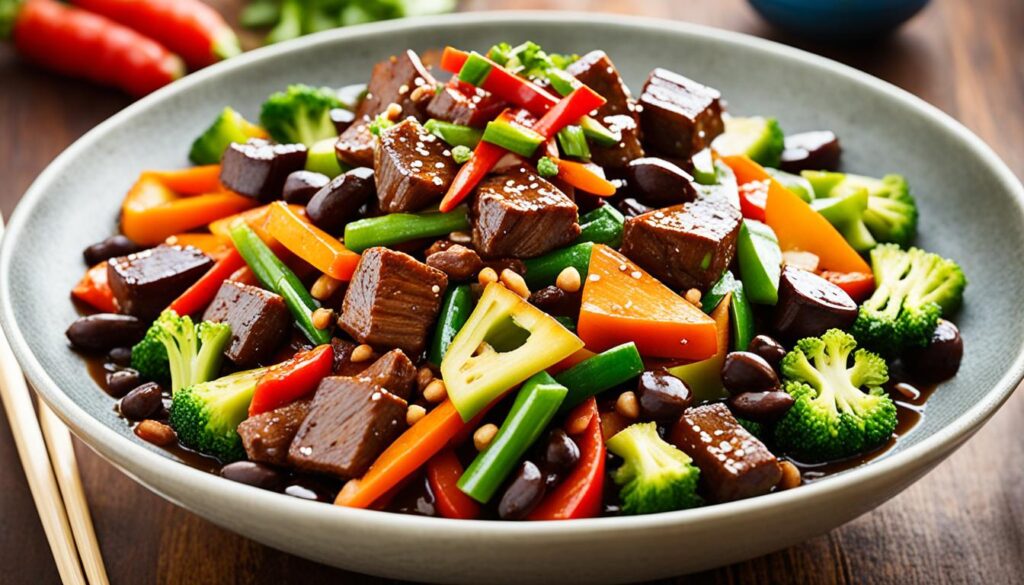
Combine plant-based meat with homemade black bean sauce for a delightful vegan beef stir fry. Enjoy it over rice or noodles for a flavorful, plant-based meal.
Thai Basil Stir-Fry with Plant-Based Chicken
Enjoy the exciting tastes of Thai food with a thai basil chicken stir-fry. It uses vegan chicken substitutes for a new twist. This dish explores aromatic thai basil‘s special scent and shows you how to use plant-based choices.
The Aromatic Allure of Thai Basil
Thai basil, sometimes called holy basil, is vital in Thai cooking. It has a unique peppery, slightly licorice taste. This herb makes stir-fries taste truly Thai, while its green with purple look adds beauty.
Versatile Vegan Chicken Substitutes
Normally, a Thai basil stir-fry recipe uses chicken. But, you can use different vegan chicken substitutes. Choices include seitan, soy curls, or firm tofu crumbles for a chicken-like feel.
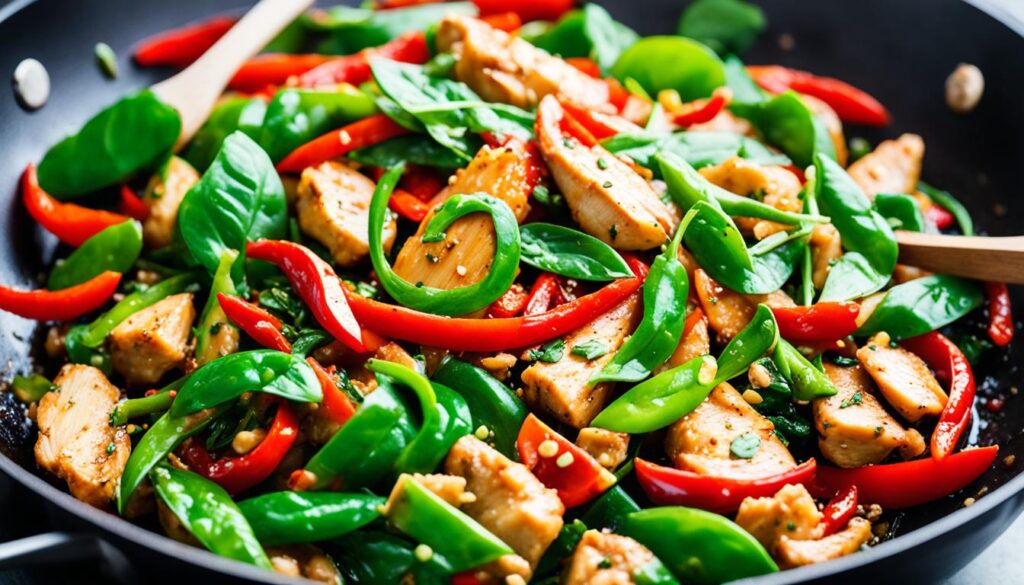
Seitan is a top choice, being wheat-based and highly flavor-absorbent. It does great in a thai basil chicken stir-fry. Soy curls, made of dried soy, also work well when soaked and flavored.
For a gluten-free version, consider crumbled tofu. It blends with Thai basil’s aroma and sauce, taking on a nice chew. With options like seitan, soy curls, or tofu, you can enjoy this Thai basil dish in sync with your diet.
- Preparation time: 10 minutes for a quick, delightful vegan meal
- Ingredients: shallots, garlic, chilies, and aromatic thai basil leaves
- Protein variations: crumbled extra-firm tofu, diced tempeh, or plant-based mock meats
Discover the enticing smell of thai basil by making this dish with vegan chicken substitutes. It’s a tasty, plant-based take on the well-loved thai basil chicken stir-fry.
Vegan Singapore Noodles
Enjoy the amazing tastes of Southeast Asia with vegan Singapore noodles. This curried noodle dish is a tasty, plant-based treat. It combines spices perfectly with fresh veggie-packed noodles.
Curried Noodle Bliss
These noodles stand out thanks to flavorful curry powder. It mixes well with turmeric and a bit of sriracha sauce. Each mouthful offers rich flavors and a gentle heat you’ll enjoy.
Veggies Galore in Every Bite
Aside from great flavors, vegan Singapore noodles are full of fresh veggies. This makes the meal both healthy and fulfilling. Tofu and herbs are also included, showing off a meal full of color and texture.
Here’s a quick overview of this recipe:
- Prep Time: 15 minutes
- Cooking Time: 20 minutes
- Total Time: 35 minutes
- Servings: 4
- Rating: 4.72 out of 5 from 7 votes
To make this dish, gather the ingredients below:
- 7 ounces of vermicelli rice noodles
- 3 tablespoons of soy sauce
- 1 ½ tablespoons of curry powder
- ½ teaspoon of turmeric
- 1 teaspoon of sriracha sauce
- 14 ounces of super firm tofu
- 2 tablespoons of canola or high-heat oil
- 4 scallions, chopped
- 3 minced garlic cloves
- 1 ½ teaspoons of freshly grated ginger
- 1 red and 1 green bell pepper
- ½ medium onion, sliced
- ¼ cup of chopped fresh cilantro
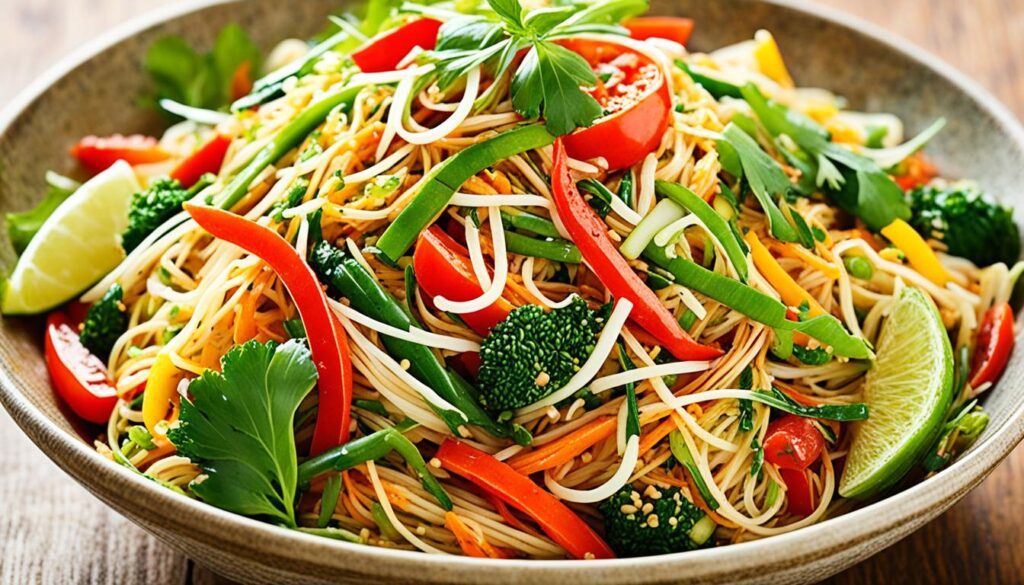
These vegan Singapore noodles with their mix of flavors and veggie goodness should be a regular in your meals. So, step into this tasty dish and enjoy the flavors of Southeast Asia!
Stir-Fried Tempeh with Peanut Sauce
Craving something tasty and vegan? Try this exciting tempeh stir fry with a delicious peanut sauce recipe. You’ll love the taste of the creamy sauce with the wholesome high-protein tempeh. It’s a match made in food heaven.
The Nutty Goodness of Peanut Sauce
Boost your stir-fry with a smooth peanut sauce recipe. This sauce mixes creamy peanut butter with coconut milk, maple syrup, and more. It creates a rich, nutty taste that makes every bite amazing.
Tempeh: A Protein-Packed Powerhouse
Looking to add more protein? A tempeh stir fry is the way to go. Tempeh is great because it’s chewy and takes on flavors well. Did you know that each block has an incredible 44 grams of protein? It’s a great choice for a tasty, nutritious meal.
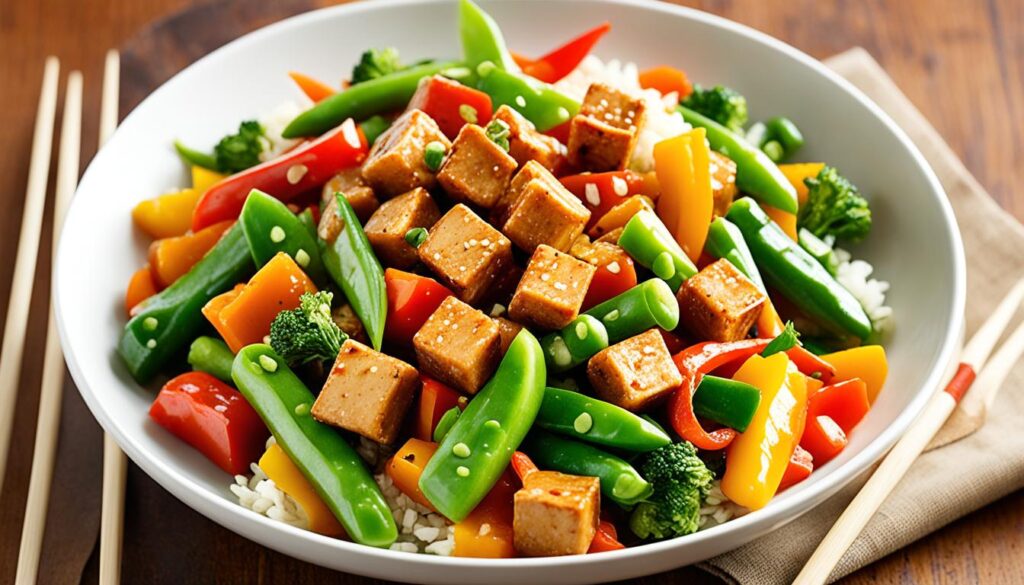
- Preparation time: 35 minutes
- Net carbs: 8.6g
- Calories: 255kcal
- Protein: 15.6g
- Fat: 15.6g
- Fiber: 6.8g
- Sugar: 4.8g
To make this dish, get olive oil, an onion, tempeh, and some veggies. You can use any veggies you like, such as broccoli and carrots. Add some peanuts and cilantro for a finishing touch. You can also add tofu or a plant-based chicken substitute if you want more protein.
This tempeh stir fry is full of flavor. With the nutty peanut sauce and rich tempeh, it’s a fantastic vegan meal. You’ll want to make it over and over again.
Vegan Chow Mein
Do you love chow mein but want a vegan twist? Try this vegan chow mein recipe. It’s full of fresh veggies and healthier than the original, but just as tasty.
A Twist on the Classic Noodle Dish
Chow mein is usually made with meat and eggs. But, this plant-based noodle stir fry is just as delicious. It uses a mix of colorful veggies to keep the taste alive in a healthier way.
Veggies Take Center Stage
In this vegan chow mein recipe, fresh veggies shine. You’ll find crunchy broccoli, sweet carrots, colorful bell peppers, and more. Spring onions and bean sprouts give it a tasty crunch. The sauce brings it all together perfectly.
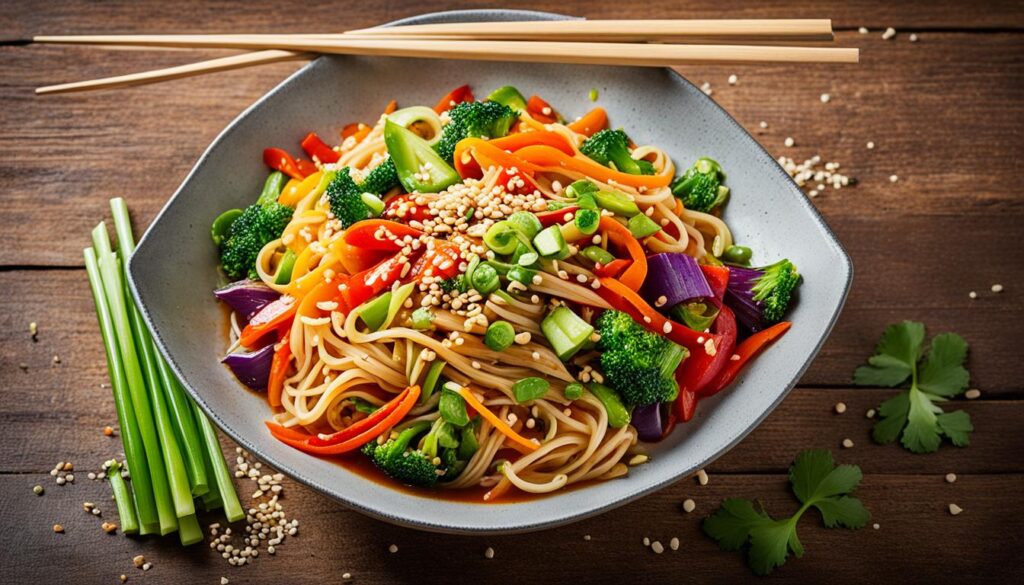
To make this veggie-packed chow mein, start by cooking garlic and shallots. Then, add the broccoli and carrots. Let them cook a little. Next, throw in the peppers, cabbage, and bean sprouts for a few minutes.
In another pot, cook your noodles. When the veggies are right, add the noodles and sauce. Mix well and you’ve got a great plant-based noodle stir fry ready!
Make it even better with sesame seeds and fresh spring onions on top. This adds more flavor and makes your dish look great.
So, if you’re vegan or just trying more plant foods, this recipe is for you. It’s a tasty way to get your veggies in and enjoy a classic dish.
Tips for Perfect Vegan Wok Cooking
Learning how to stir fry veggies in a wok the vegan way is key. Doing it right means getting meals packed with flavor and perfectly cooked. After cooking as a hobby, I’ve picked up important tips that make my vegan wok dishes stand out.
Start by getting your wok really hot. A high temperature means vegetables keep their crunch and color while cooking fast. To do this, heat your wok on high until it begins to smoke a bit. Then, you’re ready to oil it up and start cooking. This quick, hot cooking forms those tasty crispy edges on your veggies.
A good trick in vegan wok cooking is to add veggies at different times. Start with the harder ones like broccoli and carrots. They take longer to soften, so give them a head start. Then, throw in the softer veggies like snow peas. This way, everything ends up cooked just right, making your stir fry a hit every time.
